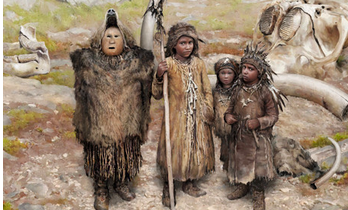Welcome to DU!
The truly grassroots left-of-center political community where regular people, not algorithms, drive the discussions and set the standards.
Join the community:
Create a free account
Support DU (and get rid of ads!):
Become a Star Member
Latest Breaking News
Editorials & Other Articles
General Discussion
The DU Lounge
All Forums
Issue Forums
Culture Forums
Alliance Forums
Region Forums
Support Forums
Help & Search
Anthropology
Related: About this forumChildren of the Ice Age
With the help of new archaeological approaches, our picture of young lives in the Palaeolithic is now marvellously vividApril Nowellis
Edited byCameron Allan McKean

Illustration by Tom Bjorklund
The sun rises on the Palaeolithic, 14,000 years ago, and the glacial ice that once blanketed Europe continues its slow retreat. In the daylight, a family begins making its way toward a cave at the foot of a mountain near the Ligurian Sea, in northern Italy. They’re wandering across a steppe covered in short, dry grasses and pine trees. Ahead, the cave’s entrance is surrounded by a kaleidoscope of wildflowers: prickly pink thistles, red-brown mugworts, and purple cornflowers.
But before entering, this hunter-gatherer family stops to collect the small, thin branches of a pine tree. Bundled together, covered with resin and set alight, these branches will become simple torches to illuminate the cave’s darkened galleries. The group is barefoot and the path into the cave is marked by footprints in the soft earth and mud. There are traces of two adults, a male and female, with three children: a three-year-old toddler, a six-year-old child, and an adolescent no older than 11. Canine paw prints nearby suggest they may be accompanied by pets.
Carrying pine torches, they enter the base of the mountain. At around 150 metres inside, the family reaches a long, low corridor. Walking in single file, with only flickering firelight to guide them, they hug the walls as they traverse the uneven ground. The youngest, the toddler, is at the rear. The corridor soon turns to a tunnel as the ground slopes upward, leaving less than 80 cm of space to crawl through. Their knees make imprints on the clay floor. After a few metres, the ceiling reaches its lowest point and the male adult stops. He then pauses, likely evaluating whether the next section is too difficult for the littlest in the group. But he decides to press on, and the family follows, with each member pausing in the same spot before continuing. Further into the cave, they dodge stalagmites and large blocks, navigate a steep slope, and cross a small underground pond, leaving deep footprints in the mud. Finally, they arrive at an opening, a section of the cave that archaeologists from a future geological epoch will call ‘Sala dei Misteri’ (the ‘Chamber of Mysteries’).
While the adults make charcoal handprints on the ceiling, the youngsters dig clay from the floor and smear it on a stalagmite, tracing their fingers in the soft sediment. Each tracing corresponds to the age and height of the child who made it: the tiniest markings, made with a toddler’s fingers, are found closest to the ground.
Snip...more...
https://aeon.co/essays/what-was-it-like-to-grow-up-in-the-last-ice-age
April Nowellis a Palaeolithic archaeologist and professor of anthropology at the University of Victoria in Canada. She is known for her publications on cognitive archaeology, Palaeolithic art, the archaeology of children and the relationship between science, pop culture and the media. She is the author of Growing Up in the Ice Age (2021).
❤️pants
1 replies
 = new reply since forum marked as read
Highlight:
NoneDon't highlight anything
5 newestHighlight 5 most recent replies
= new reply since forum marked as read
Highlight:
NoneDon't highlight anything
5 newestHighlight 5 most recent replies
Children of the Ice Age (Original Post)
littlemissmartypants
Jan 2024
OP
Easterncedar
(5,441 posts)1. Very interesting article. Thanks!